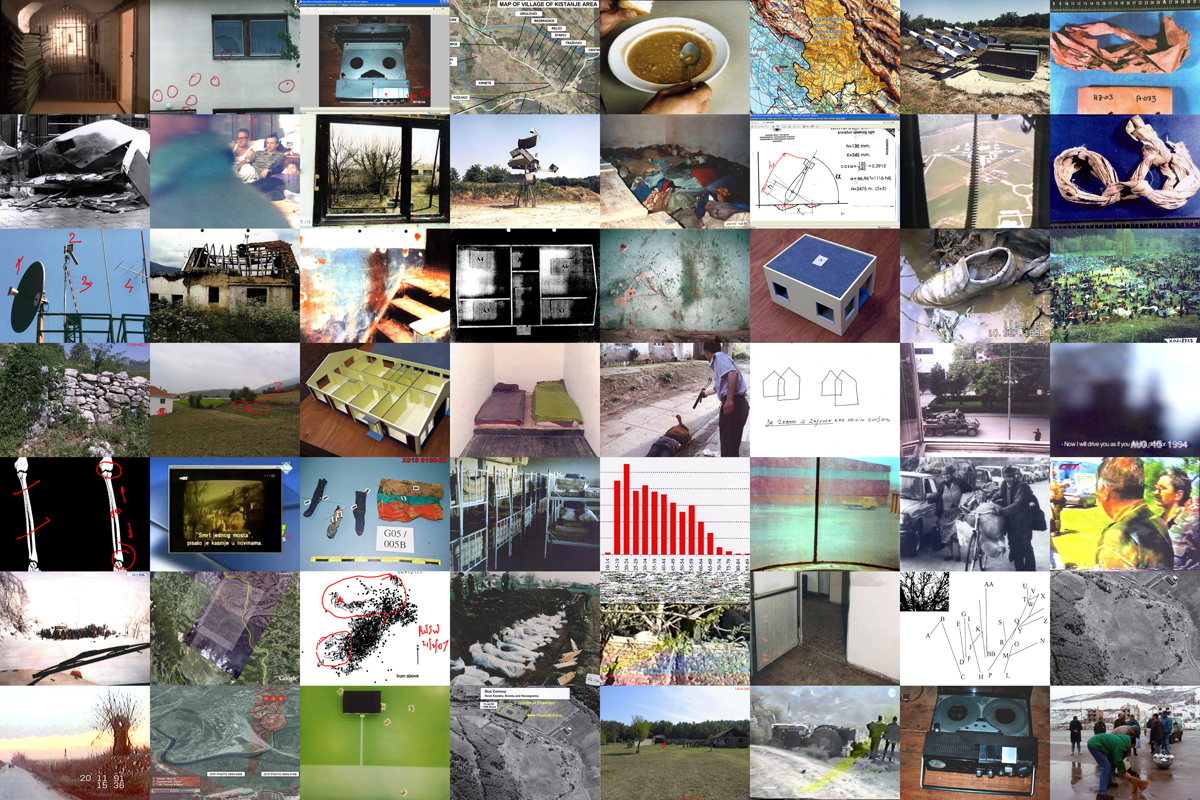This project explores the legal archive of the International Criminal Tribunal for the former Yugoslavia, whose holdings are now in excess of 9.3 million and include photographs, diaries, maps, diagrams, exhumation records, x-rays, radio intercepts, audio recordings, and videotapes, as well as physical objects such as scale models, computer hard drives, personal effects, munitions, and even remnants of charred timber and stone. All is here, save bio-hazardous materials such as blood-soaked clothing, which would have been documented and then disposed of.
In addition to these exhibits, transcripts and procedural documents are also scanned and entered into the e-court database. All materials presented during a trial are viewed electronically on desktop monitors where witnesses also have the opportunity to mark them using a digital stylus.
A selection is presented here that emphasises the degree to which the court imprints its legal protocols upon evidential materials and in the process also actively shapes them. The project provides a cross-section of various exhibits that were entered into evidence during the tribunal. In doing so it also provides insight, that is to say, ‘evidence’ of the complex processes whereby such matter—media artifacts and physical objects—were converted into things that matter legally: namely evidence of war crimes.
Description: Photographic installation of 42 copies of evidence sourced from the ICTY Court Records presented on a light-table. Includes a single-channel wall-mounted video detailing the presentation of this evidence in court (100 mins).
Evidence on Trial, See you in The Hague, Stroom Den Haag, NL (2014)
Forensis, Haus Der Kulturen der Welt, Berlin, (March 2014)
“Should Videos of Trees have Standing? An Inquiry into the Legal Rites of Unnatural Objects at the ICTY.” A Cultural History of Law in the Modern Age. Eds. Celermajer, Danielle and Richard Sherwin. London: Bloomsbury, 2018.
“Law and Disorder.” Realism Materialism Art. Ed. Christoph Cox, Jenny Jaskey, Suhail Malik. Berlin: Sternberg Press, (2015); 137-43.
“Entering Evidence,” Forensis: The Architecture of Public Truth. Ed. Forensic Architecture, Berlin: Sternberg Press, (2014): 279-314.
In addition to these exhibits, transcripts and procedural documents are also scanned and entered into the e-court database. All materials presented during a trial are viewed electronically on desktop monitors where witnesses also have the opportunity to mark them using a digital stylus.
A selection is presented here that emphasises the degree to which the court imprints its legal protocols upon evidential materials and in the process also actively shapes them. The project provides a cross-section of various exhibits that were entered into evidence during the tribunal. In doing so it also provides insight, that is to say, ‘evidence’ of the complex processes whereby such matter—media artifacts and physical objects—were converted into things that matter legally: namely evidence of war crimes.
Description: Photographic installation of 42 copies of evidence sourced from the ICTY Court Records presented on a light-table. Includes a single-channel wall-mounted video detailing the presentation of this evidence in court (100 mins).
EXHIBITIONS
Evidence on Trial, See you in The Hague, Stroom Den Haag, NL (2014)
Forensis, Haus Der Kulturen der Welt, Berlin, (March 2014)
WRITING
“Should Videos of Trees have Standing? An Inquiry into the Legal Rites of Unnatural Objects at the ICTY.” A Cultural History of Law in the Modern Age. Eds. Celermajer, Danielle and Richard Sherwin. London: Bloomsbury, 2018.
“Law and Disorder.” Realism Materialism Art. Ed. Christoph Cox, Jenny Jaskey, Suhail Malik. Berlin: Sternberg Press, (2015); 137-43.
“Entering Evidence,” Forensis: The Architecture of Public Truth. Ed. Forensic Architecture, Berlin: Sternberg Press, (2014): 279-314.




Entered into Evidence was commissioned by Forensic Architecture & HKW.
WORKS